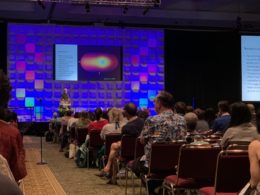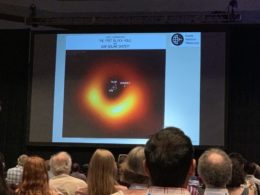Editor’s Note: This week we’re at the 235th AAS Meeting in Honolulu, HI. Along with a team of authors from Astrobites, we will be writing updates on selected events at the meeting and posting each day. Follow along here or at astrobites.com. The usual posting schedule for AAS Nova will resume the week of January 20th.
Plenary Lecture: Diet of the Stars: Mass Accretion and Mass Loss (by Ellis Avallone)
“A picture is worth a thousand words, but a spectrum is worth a thousand pictures,” says Dr. Andrea Dupree (Center for Astrophysics | Harvard & Smithsonian). The first plenary of the day was on stellar spectroscopy, Dupree’s specialty, and the power it gives us in understanding stellar processes.
The talk focused on two main topics in stellar astrophysics: mass accretion and mass loss. There are many outstanding questions related to these processes, like their effects on the star, the star’s environment, and the planets around the star. However, answers to these questions remain conjectures until we can look at a star’s spectrum.
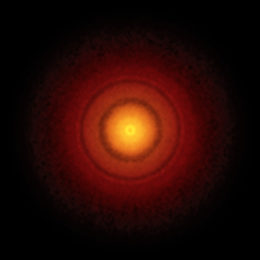
An ALMA view of TW Hya, a young star surrounded by a protoplanetary disk. [S. Andrews (Harvard-Smithsonian CfA)/B. Saxton (NRAO/AUI/NSF)/ALMA (ESO/NAOJ/NRAO)]
To understand the accretion process in this system, Dupree then launched a campaign to observe TW Hya, a young star, in multiple wavelengths. Using spectra obtained by the Chandra X-Ray Observatory, Dupree was able to obtain full plasma diagnostics for the young star’s atmosphere and follow accretion onto TW Hya through time. “Veiling” was also observed — a process by which accretion onto the surface of the star produces emission that “fills in” absorption lines. This phenomenon has also been observed on the most well-studied star in the universe, the Sun. After a solar flare, material falls back to the solar surface, which produces the enhanced emission that causes veiling. Therefore, the Sun can act as a proxy when trying to understand accretion on young stars.
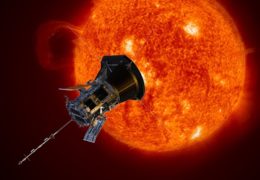
Illustration of the Parker Solar Probe spacecraft approaching the Sun. [NASA/Johns Hopkins APL/Steve Gribben]
Dupree concluded her talk with a discussion of Betelgeuse, which has been a hot topic recently. It’s been fading and is the faintest it’s been in nearly 50 years. Does this mean it’s about to go supernova? We’ll just have to wait and see. This, and other unanswered stellar questions may soon be answered by a spectroscopist near you.
Special Session on Mauna Kea (by Mia de los Reyes and Ellis Avallone)
This special session focused on Hawaiian perspectives on Maunakea and the Thirty Meter Telescope. The panel consisted of four kānaka maoli (indigenous Hawaiians) and was moderated by Noelani Kalipi (Kohala Institute, Executive Director).
The panel began with a presentation from two kia’i, or protectors of the mauna. The first speaker, Pua Case, one of the leaders of the Ku Kia’i Mauna movement, sought to set the tone of the session. Protectors of Maunakea practice kapu aloha, a philosophy of nonviolence that has been heavily present in the movement to protect Maunakea. Case went on to say that “the focus of [the session]was not to debate.” Rather, the focus of this special session was to listen and learn from each other, and its purpose was to transport astronomers to the mauna and invite them to visit and learn.
Case then played a video that urged the audience to think about what is sacred and to work to understand the relationship between the people and the sky. The short film concluded directly: “We [kia’i] speak for the mountain and the mountain says no.”
Case then discussed ceremony that takes place at the Mauna, demonstrating the chant done on the Mauna three times a day. Case also outlined the importance of bringing offerings — something meaningful brought for the land or elders.

Mauna Kea, as viewed from Mauna Loa Observatory. [Nula666]
The kia’i’s portion of the session was concluded with another ceremony led by Pua Case for acknowledging the information the audience had just received. The purpose was to leave astronomers with “kuleana” (responsibility). Case left the audience with a powerful statement: “We are not a camping trip on the mountain, we are not your luau, this is not a whim.” Case urged the audience to understand the land and know how you will impact it and its people before you come.
The next part of the session was led by two native Hawaiian astronomy graduate students, Makana Silva (The Ohio State University) and Tyler Trent (University of Arizona), who both indicated that they support the Thirty Meter Telescope project. Silva began by stating that as a native Hawaiian, his view and perspective were just as important as that of the kia’i, and that perspectives vary even amongst native Hawaiians. He explained that with the telescope, he can practice his culture today in a modern fashion and carry Hawaiian’s long-standing practice of astronomy into modern times. Silva also quoted the environmental impact statement and cultural impact statement, which claim that the Thirty Meter Telescope will not disturb the summit, but said he would reassess if other studies were to come forward. He concluded his statements by saying that “the Thirty Meter Telescope is something that Hawaiians can leave as a legacy for the next generation.”
Next, Trent outlined his perspective on the Thirty Meter Telescope project, primarily focusing on potential consequences if the project left Hawai`i. He lists the telescope’s scholarship fund for the advancement of children in Hawai`i and the workforce pipeline as notable ventures that would be lost. Trent also remarks that “astronomy gives Hawaiians an opportunity to advance economically” outside the other primary industries of tourism and the military. Additionally, the rejection of the Thirty Meter Telescope sheds a negative light on astronomy and acts as a symbolic rejection of astronomy.
For more information on this multifaceted issue, see our previous astrobites (here and here) and the links within them.
Press Conference: Cosmology & Exoplanets: Beyond the Nobel Prize (by Susanna Kohler)
This morning’s press conference was moderated by our very own Tarini Konchady, Astrobites author and AAS Media Fellow. Tarini introduced the panel’s topic — Cosmology & Exoplanets — with the explanation that the somewhat odd pairing was inspired by the split of the most recent Nobel Prize.
First up, Daniel Gilman opened with new work on how gravitational lensing is helping us to refine our understanding of dark matter. Different models of dark matter disagree: are the particles primarily “warm” or “cold”? These temperatures refer to the particles’ speed — and since warm particles move faster, they tend to wipe out small-scale structure. To determine which of these models is a better fit to our observations, Daniel Gilman (University of California, Los Angeles) and collaborators used the Hubble-observed gravitational lensing of distant quasars to hunt for evidence of small-scale dark-matter structure in the invisible halos of intervening galaxies. The team’s discovery of small clumps of dark matter has caused them to declare the warm dark matter picture unlikely, instead favoring the cold dark matter model. Press release
First up, Daniel Gilman tells us about how gravitational lensing is telling us about the nature of dark matter. #aas235 pic.twitter.com/41afBteA4w
— astrobites (@astrobites) January 8, 2020

Each of these Hubble Space Telescope snapshots reveals four distorted images of a background quasar surrounding the central core of a foreground massive galaxy. [NASA, ESA, S.H. Suyu, and K.C. Wong]
We next transition to exoplanets, with Jason Wright (Penn State University) introducing NEID, an extreme-precision Doppler spectrograph that recently saw first light (see the cover image above). NEID (pronounced NOO-id) was installed on the 3.5-meter WIYN telescope at Kitt Peak National Observatory, and it will help us search for radial-velocity wobbles caused by the tug of planets on their host stars. NEID will have a precision roughly three times greater than previous generation state-of-the-art instruments, allowing us to detect wobbles of just 30 cm/s. For reference, the Sun’s wobble induced by Earth is about 10 cm/s, and Jupiter’s influence is around 1,200 cm/s. NEID is expected to start its main science mission this year. Press release
Last up, Edward F. Guinan (Villanova University) used a series of stellar surveys to sell us on K stars as the best target in the search for habitable exoplanets. These dwarfs — which are slightly cooler and less luminous than the Sun — have stable lifetimes of 15 to 50 billions of years (in comparison to our Sun’s ~10 billion years), giving planets plenty of time to evolve life forms. While K dwarfs aren’t as common as M dwarfs, they’re still more frequently found than Sun-like stars. And, importantly, they’re much less volatile than M dwarfs, which notoriously flare in high-energy emission. K-dwarf habitable zones are larger, which is another advantage relative to M dwarfs: for M dwarfs, “If you want to be warm, you have to be close — but you’re getting close to a nuclear power plant,” Guinan points out. K dwarfs might just be the Goldilocks star we want … so let’s go hunt some habitable planets! Press release
Special Session: New Horizons Results at 2014 MU69 (by Briley Lewis)
In this special session, we get a taste of some planetary science, thanks to the New Horizons Kuiper Belt Extended Mission team. They report on the scientific results from the spacecraft’s 2019 flyby of Kuiper Belt Object (KBO) 2014 MU69, now formally known as Arrokoth.
New Horizons PI Alan Stern started off with an overview of the mission. After its flyby of Pluto, the spacecraft was operational and ready to find a new target to further explore the outer solar system. Targeting MU69 was difficult, since it’s much smaller than Pluto (see image) and we were only able to observe about 1% of its orbit before flyby. It’s a cold classical KBO, meaning it was born at its current distance from the Sun and has low eccentricity and inclination. It’s about 33 km long, and it looks like two disks smushed together, known as a contact binary. Learning more about MU69 can tell us about how it formed, which in turn gives information on the conditions of the early solar system.
But before we talk about MU69, Marc Buie tells us about how we got the spacecraft there in the first place. To find a new destination, there was a lot of searching, including massive campaigns with ground-based telescopes to look for occultations, where the KBO passes in front of a distant star, giving us information on its size and shape based on the starlight it blocks out in transit. The team led multiple campaigns — spread through South Africa, Argentina, and even on the SOFIA airplane-based observatory — and got enough observations to narrow down their predictions on the shape and ensure the spacecraft would be in the right place for the flyby.
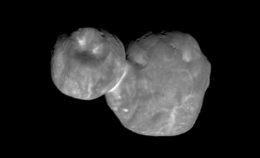
The bi-lobed object MU69, as captured by NASA’s New Horizons spacecraft during its flyby. [NASA/Johns Hopkins University Applied Physics Laboratory/Southwest Research Institute]
All signs point to a “gentle” merger leading to the contact binary, since if the two lobes were moving faster than 2.5 meters per second, they would have destroyed or significantly altered each other on impact. These slow collision speeds (and other evidence, like Singer’s cratering results) point to cloud collapse instead of hierarchical accretion for how planetesimals form — an important result for planet formation!
Plenary Lecture: The Future of Infrared Astronomy in the Context of Spitzer, SOFIA, and JWST (by Briley Lewis)
Spitzer is nearing its last days — the famous infrared satellite is shutting down at the end of the month, January 30th, 2020. Peter Eisenhardt (JPL) takes us on a tour of Spitzer’s greatest hits, illustrating the telescope’s lasting legacy. He tackles three main questions through the lens of Spitzer observations: where did we come from, how did the universe evolve, and are we alone?
For almost 17 years, Spitzer has been observing the infrared sky, peering into distant galaxies to answer those first two questions. It has estimated the rate at which stars form over the history of the universe, and also the mass density of those stars, giving us an idea of how the universe has changed over time. Spitzer has also provided great information on exoplanets, trying to answer the fundamental question of our place in the universe; it created the first exoplanet phase curve and temperature map, and was essential to the confirmation of the famous TRAPPIST-1 system.
Now, it’s spending its last days observing distant galaxies as part of a precursor survey, providing important context on where JWST and other future missions should point to see the early universe. It has also already observed many of the planets planned for early JWST observations, paving the way for the success of these future studies.
Next, James De Buizer (SOFIA Science Center) told us about SOFIA, the only far infrared observatory available for astronomy until the proposed Origins Space Telescope, planned tentatively for the 2030s if selected by the decadal survey. This unique facility — a telescope on an aircraft — flies up above the parts of the atmosphere that block far-IR light. Since SOFIA isn’t in orbit, it’s easily serviceable and upgradable, making it a flexible and powerful resource for infrared astronomy.
It’s already made numerous important contributions to astronomy: observations of the galactic center, mapping of star formation in the Orion Nebula, information on the importance of galactic outflows in the intergalactic medium (all the stuff between galaxies), and signatures of helium hydride, a tracker of how molecular hydrogen formed before there was enough dust in the early universe. De Buizer emphasizes that this is the only far infrared observatory that we’ll have access to for the next few years, making it absolutely integral to other upcoming missions such as JWST. There’s a lot SOFIA will be able to do to complement the science done by other new observatories!
Press Conference: Astronomy Confronts Satellite Constellations (by Aaron Tohuvavohu)
[Coming soon!]
Newton Lacy Pierce Prize: Life and Times of the Lowest Mass Galaxies (by Mia de los Reyes)
As #AAS235 began winding down, Daniel R. Weisz (University of California, Berkeley) gave the second-to-last plenary of the day. After discussing the importance of dwarf galaxies and the many astrophysical questions they can be used to answer, Weisz focused on dwarf galaxies as tools for “near-field” cosmology. Nearby dwarf galaxies are analogs to the lowest-mass galaxies at high redshifts, and they can shed light on some of the events that happened in the early universe.

NGC 147, a dwarf spheroidal galaxy in the Local Group. [Ole Nielsen]
With these data, Weisz’s group aimed to investigate the link between dwarf galaxies and reionization, the epoch in the universe when the neutral universe was ionized by high-energy UV photons. First, Weisz asked how dwarf galaxies were affected by reionization. By seeing what dwarf galaxies’ star formation histories looked like before and after the epoch of reionization (which lasted roughly between redshifts 6–10), his group showed that reionization quenched star formation in the lowest-mass objects, called “ultra faint dwarf” galaxies.
Did reionization ionize ultra faint dwarfs at the time, ceasing star formation?
Yes. These seem to quench, and more so for the lowest mass objects! #AAS235 pic.twitter.com/goZEDvCUOK
— Locke Patton (@Astro_Locke) January 9, 2020
Weisz then asked how dwarf galaxies might contribute to reionization. From the star formation histories of dwarf galaxies, one can estimate how the ultraviolet luminosity of dwarf galaxies changed over time. Weisz’s group used this to figure out how much dwarf galaxies — in particular, the “ultra-faint dwarfs,” which are expected to be extremely common — would have contributed to reionization.
It turns out that ultra-faint dwarf galaxies must have been rarer than expected, otherwise they actually contribute too many high-energy photons to explain our observations of reionization! In the future, the James Webb Space Telescope will allow us to check this directly by actually doing a statistical census of the number of ultra-faint dwarf galaxies.
However, all of these results are based on observations of the dwarf galaxies around the Milky Way. Are these Milky Way satellites truly representative of all dwarf galaxies? “The natural place to answer this question is M31,” according to Weisz, since it’s the nearest system of satellite galaxies. He compared the star formation histories of Milky Way satellites with those of M31’s satellites, and preliminary results seem to show some differences! Around the Milky Way, ultra-faint dwarfs “quench” (finish most of their star formation) very early, while more luminous galaxies quench late. In the M31 system, none of the dwarf galaxy satellites quench quite as early as the Milky Way galaxies; most of them actually quench at intermediate times! These suggest that the Milky Way system is unique, and that studying the Milky Way satellites alone might give us a biased view of dwarf galaxies.
More data are needed to answer these questions. Weisz is leading an ongoing project to obtain more data from HST. In the future, hopefully we’ll be able to study more distant galaxies. JWST — and next-generation larger space telescopes — will enable measurements of individual stars in galaxies at further distances, letting us test if dwarf galaxies in our Local Group (of which M31 and the Milky Way are the two biggest galaxies) are unique.
Lancelot M. Berkeley Prize: The Event Horizon Telescope: Imaging a Black Hole (by Briley Lewis)
One of the biggest science events of this year was the first image of a black hole. Sheperd Doeleman (Center for Astrophysics | Harvard & Smithsonian) represented the Event Horizon Telescope (EHT) team today to talk about the journey to that amazing first image of a black hole, and where EHT is going in the future.

Eight stations of the EHT 2017 campaign over six geographic locations. [EHT Collaboration et al 2019]
The team took existing radio telescopes all around Earth — even at the South Pole — and added technology to them, such as extremely precise hydrogen maser clocks, to link them together into one powerful instrument and achieve this goal. This Earth-sized telescope uses the idea of very long baseline interferometry (VLBI) and produces so much data that the fastest way to transfer all of it is by flying a bunch of hard drives somewhere in an airplane. Once they had their first data, the EHT team divided into four groups to analyze the data, in an effort to avoid human bias. They all came up with remarkably similar images, showing good agreement on the basic structure of the shadow of the black hole in a different galaxy, M87.
So, what did they find in this first black hole observation? M87’s black hole is huge, around 6 billion times the mass of the Sun. Also, it looks like the spin of the black hole is comparatively unimportant to the features we see, but the metric used for general relativity is very important.
Looking to the future, adding more telescopes will lead to better images. Doeleman calls this the “ngEHT” (next generation EHT). The near future goals include: adding three new stations (Greenland, Kitt Peak, and NOEMA), looking at the polarization of M87, imaging our very own Sgr A*, and adding even more telescopes beyond the already planned three. By the end of the decade, he hopes to have better angular resolution and dynamic range, with the goal of imaging and understanding the connection between a black hole and its jets.
Given that Sgr A* is so nearby, and such an interesting target for our studies of the galactic center, why hasn’t the team imaged it yet? Sgr A* is variable on much smaller timescales than M87, which presents difficulties considering the EHT has to wait for the Earth to rotate to get more baseline coverage from the telescopes. Someday telescopes in low Earth orbit could solve this problem, making time-domain movies of black hole variability.
This first image of a black hole has been an international sensation, and Doeleman doesn’t underestimate the effect his team’s work has had; the image has been seen by 4 billion people, and now he’s trying to use their success to bring the public into science. This has been a huge collaborative effort, too, with 250 team members spread across 60 institutes and 20 countries. As Doleman says, “If you want to go far, go together. To work on the biggest questions and succeed is indescribable … and we are not done yet.”



